- Accueil
- > L’Oeil du Spectateur
- > N°10 — Saison 2017-2018
- > Ancient Rome: now on Twitter! Shakespeare’s Roman Tragedies directed by Ivo van Hove. Théâtre de Chaillot, 1st July 2018
Ancient Rome: now on Twitter! Shakespeare’s Roman Tragedies directed by Ivo van Hove. Théâtre de Chaillot, 1st July 2018
Par Anne-Kathrin Marquardt
Publication en ligne le 12 juillet 2018
Texte intégral
1It is certainly an unusual theatrical experience which Ivo van Hove has in store for his audience, as his Toneelgroep Amsterdam visit the Théâtre de Chaillot again after more than two years. In 2016, his mise-en-scène of Shakespeare’s histories, Kings of War, had already been very well received1. His take on the Roman tragedies – Coriolanus, Julius Caesar, Antony and Cleopatra – similarly hits the mark2.
2The rules governing this nearly six-hour long extravaganza are explained to the audience during the first break. There are no traditional intermissions, only breaks when the set needs to be changed, which can vary between 3 and 10 minutes in length. These cut up the text into sequences lasting perhaps 45 minutes or more; but the breaks never take place between two plays, with the transition always happening onstage. During these interruptions, the audience is free to change seats or come and sit onstage on one of the many sofas provided, while a countdown tells them how much time is left. Two bars on the stage itself are there to convince even the most reluctant.
3At first sight, this looks like a relatively immersive theatrical experience, just short of the kind of theatre which companies such as Punchdrunk have become famous for. Yet, what one gets is the exact opposite as strategies of Verfremdung are used to maximum effect. Screens, for instance, are an important part of this performance.
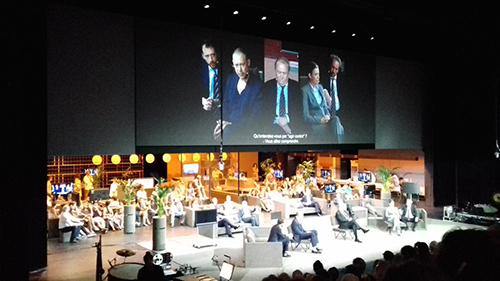
Illustration 1. Marc Antony (second from left) and Octavius (second from right) negotiate. A giant screen covering the entire upper part of the stage space (in this case, with a split screen effect) is used to show what happens onstage, as well as the subtitles.
Photo: Isabelle Debyser, used by kind permission.
4Almost everything is visible to the audience, including the makeup department and musical instruments used to create sound effects. Killings are codified affairs and – even in the case of Julius Caesar – entirely bloodless. Stroboscopic light effects with loud drum music symbolise wars and battles. Some roles, such as Casca or Octavius, are played by women with appropriate adaptation of the pronouns. The texts themselves are heavily cut, so much so that a good knowledge of the stories is required to be able to follow. The fact that the performance is very long and entirely in Dutch certainly contributes to the sense of alienation one might feel.
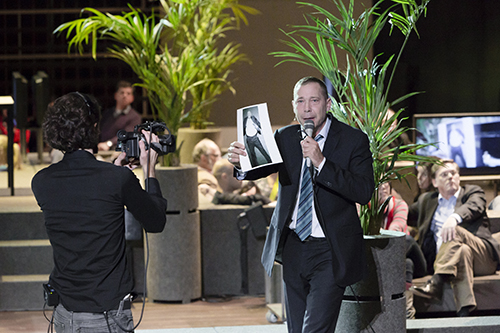
Illustration 2. Mark Antony holds up a picture of Julius Caesar’s dead body. He is being filmed and the footage displayed on TV screens onstage for the spectators lounging on the sofas. These TV screens are also used to show the subtitles or footage from various TV shows.
Photo: Jan Versweyveld, used by kind permission of Théâtre Chaillot.
5The most striking aspect remains the fact that there is no clear-cut separation between stage space and audience space. One can move around freely even during the performance, provided one does not make too much noise; one can also leave the room entirely and come back in later. Spectators are queuing for drinks or munching their quinoa salads onstage while some of Shakespeare’s rhetorical masterpieces are being delivered right next to them. The audience’s experience is thus quite close to that of the early modern spectator: long plays, no obligation to be present all the time, snacks.
6But the absence of complete immersion can also be interpreted in a different way. As is often the case with the Roman plays, the audience is cast in the role of plebeians. In Coriolanus, the tribunes are placed among the spectators as they argue with the representatives of the patricians. The audience/plebs thus find themselves in a position of extraordinary passivity, idly taking in the great spectacle of world affairs and political assassinations… unless their sandwich happens to be more interesting at that particular moment. Some of the TV screens show footage of real news (for example President Macron’s visit to the United States), suggesting that the inertia of the masses is the same in ancient Rome and modern Paris.
7This idea is foregrounded in a particularly surreal moment. Enobarbus delivers a long tirade preceding his death while running out of the theatre and into the open, followed by a camera so as to allow the audience inside to see him onscreen. The bulk of the tirade is thus delivered in Dutch by a rumpled middle-aged man, sitting on the steps leading down from the Esplanade du Trocadéro to the Eiffel Tower, while uncomprehending tourists from around the world look on, gawping in dismay… and, crucially, are not doing anything. Drawing cheers from the spectators, this sequence also holds up a mirror to them: do we really understand the events we witness – do we even care?
8Compressing three plays into 5 hours and 45 minutes (a short time, seen in this light) enhances this effect even further. Transitions between plays are seamless, allowing the audience to spot the parallels: Julius Caesar opens on a discussion of the protagonist’s haughtiness, just after we saw Coriolanus fall for a somewhat similar vice. Together with a cut text that focuses on the essentials, this helps to highlight the repetitive nature of political life. In all three plays, we witness homoerotic friendships, relationships of convenience, dishonest generosity from victors, insincere flattery from losers.
9Most of all, deaths and assassinations abound. People become corpses by simply lying down on a kind of slab in the middle of the stage, which is mounted on rails so it can slide gracefully towards the backstage area. The repetitiveness suggests that even the greats of this world are nothing but poor players that strut and fret their hour upon the stage, and then are heard no more. Once again, the news footage displayed onstage suggests that this universal rule applies to all leaders: President Trump will end up on that slab in the same way as Brutus did.
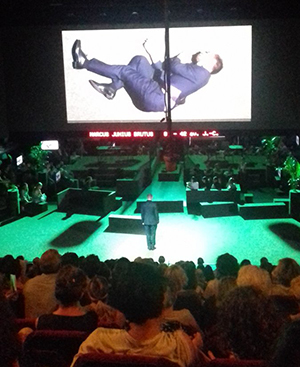
Illustration 3. Brutus is dead. Deaths are marked with drumroll, a freeze-frame picture of the body on the big screen, the name and dates flashing up in the subtitles. The body itself has already disappeared from the slab in the middle of the stage.
Photo: Isabelle Debyser, used by kind permission.
10The fact that ultimate annihilation creeps up on everyone with the inevitability of fate does not necessarily make it tragic, however. The performance does contain touches of humour, and death is no exception to this treatment. Is Enorbarbus’s passing still tragic after his impromptu sightseeing tour? Tullus Aufidius unintentionally draws laughs from the audience by his taciturn attitude and grudging answers during an interview with an ever-smiling news presenter. During the first break, the subtitles gleefully announce 5 minutes until the death of Coriolanus, 120 minutes until the death of Julius Caesar, 300 minutes until the demise of Cleopatra. As Karl Marx once put it, every event in history happens twice: the first time as tragedy, the second as farce3.
11When I claimed earlier that there is no separation between stage space and audience space, that statement therefore needs qualifying. Actors and audience may share the same space. But instead of creating a sense of common purpose, this close juxtaposition merely underscores the difference. We are next to the greats; we are not of them. They act, we watch; they die, we go on.
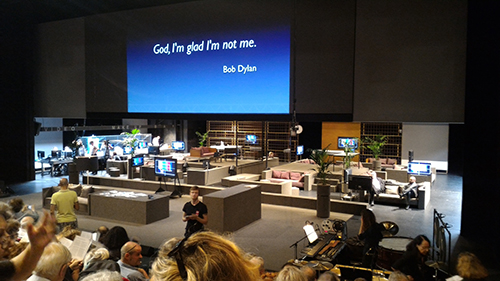
Illustration 4. The stage just before the performance starts. At the back to the left, one can spot the video department, the makeup department and one of the bars. Spectators will soon be lounging on the sofas, while the actors usually play at the front of the stage or on one of the raised platforms.
Photo: Anne-Kathrin Marquardt.
12The numerous screens onstage create yet another barrier between actors and spectators. The set is quite big: if the last row is to see the expression on Cleopatra’s face, if people sitting on a sofa with their backs to the actors are to see the subtitles, then the screens become a necessity. But it goes further than this. A few scenes are played in the wings and are visible to the audience solely on the screens. On several occasions, the actors find themselves playing more for the camera than for the audience actually present in the room. The very concept of a live theatre performance is called into question: are we watching a play or a film?
13This dovetails with the question of perspective. Whether you sit in the last row or in the first, whether you sit onstage to the left or the right, the back or the front… you will never see the exact same thing. Only the screens show the same pictures to everyone – a content that is of course edited by technical support staff, who are also present onstage. And it is a content that may be quite different (e.g. a close-up of an actor’s face) from what you see when you look directly at the scene (e.g. two characters arguing).
14As Shakespeare’s more political plays amply demonstrate, performance is an art that is common to both politics and theatre. But this mise-en-scène updates this idea: the real performance emerges in the gap between what we can see with our own eyes and what is fed to us onscreen. These political characters seem to live edited lives, for and in the screen. So can the audience check their performance against what they can see for themselves right in front of them, against the truth? Not always: the camera often sees what the spectators cannot. It is not only the concept of live theatre that is called into question: it is the idea of “the evidence of my own eyes” that is challenged.
15Spectators present onstage often find themselves looking at screens to watch scenes that are being played out only meters away from them. The spectacle of politics comes to many in edited and mediated form – if there is a “truth”, then it is often lost on at least part of the audience. But this would not be a twenty-first century performance if it did not take these ideas one step further than the TV age.
16Spectators were explicitly encouraged to take pictures and post them on social media; phones could be recharged onstage. Tweets were then displayed in the same space as the subtitles (one example: “RIP Coriolanus, mama’s boy”). The entire performance thus ends up on yet another screen: the black mirrors of our smartphones. It too becomes absorbed in this endless mise en abyme of one screen displaying what another screen had already shown – only slightly cut, slightly edited, slightly out of context. Is there actually a difference between the world as it appears on a leader’s Twitter feed and the world as I can see it with my own eyes? Reality may no longer be accessible, hidden behind the screens that purport to copy it.
17Highbrow Shakespeare thus becomes part of a pop culture made up of Twitter and Instagram. It comes as no surprise that the footage displayed on some TV screens onstage does not only come from the evening news – there are also weather reports about an approaching hurricane, music videos by Beyoncé and Britney Spears, amongst others. Mark Antony and Cleopatra’s debauchery is celebrated to the sound of the Red Hot Chili Peppers’ “Hump de Bump”, while the clip is displayed on the big screen. The suggestion is that politics has been absorbed into pop culture, which itself becomes a mere update on the age-old concept of populism. In both cases, the image projected onscreen is more important than “reality”. But as this performance becomes part of the same endless pop culture loop via the smartphones of the audience, the notion of theatre as a live event also disappears behind a wall of screens.
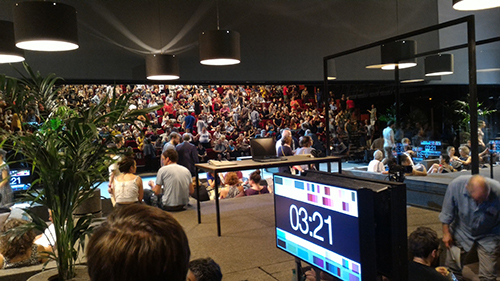
Illustration 5. The view from the stage during one of the breaks – 3’21’’ to go until the performance resumes. The actors usually play on the raised platforms (here, we can see a desk with a laptop in that area) or at the front of the stage. Above the stage the giant screen can be spotted.
Photo: Anne-Kathrin Marquardt.
18In this context, is it even possible to really engage with the performance?
19Spectators were not allowed onstage for the last sequence, which was particularly long, and the bars onstage were closed. The audience went back to being just that: people quietly sitting in their chairs, looking straight ahead, directing their gaze on the focal point of the stage. Paradoxically this was done for Antony and Cleopatra: the one play that cannot unreservedly be called a tragedy. In this performance in particular, the couple often appear ridiculous: the Queen of Egypt, controlled by sex, is an overemotional, irrational caricature of the frailty of woman, while Mark Antony somehow consistently makes the wrong choices and even fails to kill himself properly. But as the spectators now finally focus on the events unfolding before them, perhaps something akin to responsiveness or even empathy may be possible. It is as though the director took back control, forcing us to make better use of the evidence of our own eyes.
20In the end, the performance came remarkably close to the early modern experience, from the freedom given to the audience to a meditation on the relationship between comedy and tragedy. At the same time it emerges as a razor-sharp analysis of the contemporary experience, where everyone seems to feel they are more tweeted against than tweeting. After proving that theatre still has something important to say about politics in the age of Twitter, the entire team, including technical staff, were given a standing ovation that lasted several minutes by an audience (myself included) that was clearly fascinated. They deserved it: after six hours, you find yourself wanting more.
Notes
1 The plays Henry V, Henry VI and Richard III were performed from 22 to 31 January 2016 at Théâtre de Chaillot. See : www.theatre-chaillot.fr/sites/default/files/upload/telechargements/prog_ivovanhove.pdf.
2 The performances, in Dutch with French subtitles, ran from 29 June to 5 July 2018 at Théâtre de Chaillot. See : www.theatre-chaillot.fr/fr/saison-2017-2018/tragedies-romaines. Press dossier : www.theatre-chaillot.fr/sites/default/files/upload/telechargements/dp_ivo_van_hove.pdf. Programme : www.theatre-chaillot.fr/sites/default/files/upload/programme/prog_ivovanhove.pdf. I wish to thank Julien Alliot for enabling me to see the performance and for his comments on this review.
3 Karl Marx, The Eighteenth Brumaire of Louis Napoleon, 1852.